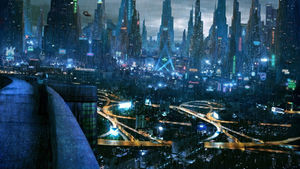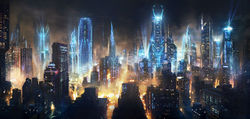Difference between revisions of "Los Angeles, N.C.D."
California (Talk | contribs) m (→History) |
California (Talk | contribs) m |
||
| Line 54: | Line 54: | ||
| population_density_km2 = auto | | population_density_km2 = auto | ||
| − | | timezone1 = [[ | + | | timezone1 = [[wikipedia:Pacific_Time_Zone|PST]] |
| utc_offset1 = -8 | | utc_offset1 = -8 | ||
| − | | timezone1_DST = | + | | timezone1_DST = PDT |
| utc_offset1_DST = -7 | | utc_offset1_DST = -7 | ||
| postal_code_type = Postal codes | | postal_code_type = Postal codes | ||
Revision as of 13:39, 11 December 2014
| This page is a work in progress by its author(s) and should not be considered final. |
| Los Angeles, N.C.D. "New" Los Angeles |
|||
|---|---|---|---|
| — Capital City — | |||
| Los Angeles, Los Angeles, NCD Skyline. | |||
|
|||
| Nickname(s): "City of Angels" | |||
| Motto: City of Flowers and Sunshine" | |||
| Country | |||
| National Capital District | Los Angeles | ||
| Inauguration of Selene Dévnostraéva | 1999 August 1 | ||
| Capital City status granted | 1999 November 19 | ||
| Legislature | Californian Empire Parliament (2465 seats) | ||
| Government | |||
| • Mayor | Cynthia R. Marlborough | ||
| Area | |||
| • Total | 2,030.55 km2 (784.00 sq mi) | ||
| Area rank | 1sta | ||
| Elevation | 93 m (305 ft) | ||
| Population (2283) | |||
| • Total | 121,589,241 | ||
| • Density | 60,000/km2 (160,000/sq mi) | ||
| Time zone | PST (UTC-8) | ||
| • Summer (DST) | PDT (UTC-7) | ||
| Postal codes | 90xxx 9xxxx |
||
| Website | californianempire.x10host.com | ||
| anot including the City of Los Angeles as a single city. | |||
Overview
Los Angeles, Los Angeles, N.C.D. unofficially the City of 'New' Los Angeles is the largest city and capital of the Californian Empire. The city of Los Angeles within the National Capital District can be described at best a city-state — as the National Capital District within the State of California by virtue of the land donated by both Los Angeles and Orange countries (prior to their merger) for the creation of the N.C.D. — is an entirely different city than the city of Los Angeles to the north, northwest and west of the N.C.D. The Los Angeles N.C.D. is located in the southern part of the State of California, inside Los Angeles County. The N.C.D. sits between the Los Angeles and San Gabriel rivers in the Los Angeles-San Gabriel River Basin. As a planned city, after the N.C.D. was established in 1999, the construction of the city and it's administrative buildings began with the city rapidly growing in size as employment opportunities drew millions of residents to the new nation's capital. According to the 2287 census, Los Angeles, Los Angeles N.C.D. is inhabited by 121,589,241 people, making it the most populated city and the most densely populated city in the Californian Empire.
As the capital of the Californian Empire, Los Angeles, Los Angeles N.C.D. hosts the Californian Empire Presidential Palace, the Californian Empire Parliament, 1 Dévnostraéva Tower, National Military Command Center, and the government offices of the Department of State Security, the National Investigative Agency, the State Intelligence Agency, and various other federal government agencies. The city of Los Angeles, Los Angeles, N.C.D. is served by the Port of Los Angeles and the Port of Long Beach which maintains the export of a majoity of the nations products, and is the primary GSP (Gross State Product) source for the State of California. Los Angeles N.C.D. also acts as one of the main transportation hubs in the Californian Empire with highways, railways and airports available for facilitating travel domestically and internationally. Los Angeles, Los Angeles N.C.D. is also served by Los Angeles International Airport.
History
Shortly after declaring independence, the new interim Parliament of the Republic of California deemed the establishment of the National Capital District a necessity, as at the time dispute arose over whether or not to host the capital of the nation in Sacramento, the city serving as the state capital. With the accession of new states, proposals were made to the new states regarding a decision to host the new national capital. Through almost unanimous refusal, the decision was made to have the State of California host the capital district of the country. A proposal was submitted to various cities and counties in the state and finally the decision was narrowed down to Los Angeles and Orange counties, only to have the competition between the two counties intensify in their bid to host the capital of the nation. The interim Parliament, determined to resolve the issue ruled in the favor of both counties instructed the government of both counties to form a committee to determine the portion of land both would cede to create the National Capital District.
Shortly after the accession of the former Canadian province of British Columbia, the city of Victoria served as the provisional capital while the 28-by-28 square mile area encompassing the N.C.D. was purchased from both counties and construction crews began the redevelopment of the area. The cornerstone for the new Capitol Building was laid on November 19, 2000 to commemorate the one-year anniversary since independence.
The Los Angeles, Los Angeles N.C.D. was established in 1999 through a Parliamentary initiative in accordance with Article 3, paragraph 3 "to assign a portion of land to be designated for the residency of the national capital, for the purposes of establishing a district to facilitate this district’s impartiality so as to remain unaffected by the legislation of any state, territory or overseas department that would affect legislation on the nation’s behalf." and paragraph 4 "to exercise exclusive legislation in all cases whatsoever over such National Capital District (not exceeding thirty miles square) as may, by cession of particular states, and the acceptance of Parliament, become the Seat of the Government of the Californian Empire, and to exercise like authority over all places purchased by the consent of the Legislature of the State in which the same shall be, for the construction of forts, magazines, arsenals, dock-yards and other needful buildings."
During the period of the Second American Civil War, the city remained untouched allowing construction of transportation avenues and various buildings within the city such as 1 Dévnostraéva Tower, the Parliament, the National Military Command Center, and the offices of the Department of State Security, the National Investigative Agency, and the State Intelligence Agency to be completed on schedule.





